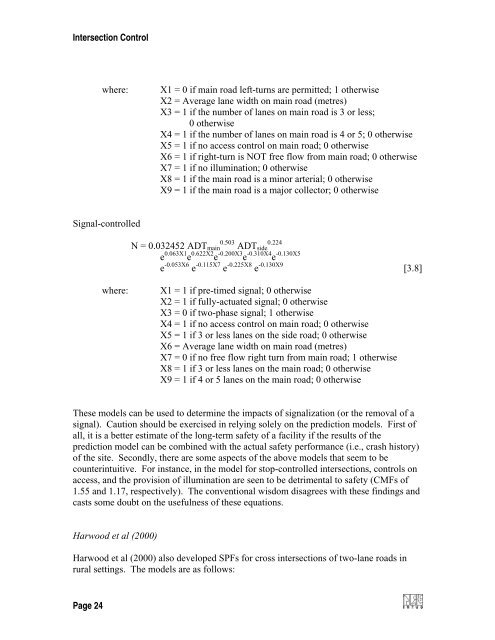Synthesis of Safety for Traffic Operations - Transports Canada
Synthesis of Safety for Traffic Operations - Transports Canada
Synthesis of Safety for Traffic Operations - Transports Canada
You also want an ePaper? Increase the reach of your titles
YUMPU automatically turns print PDFs into web optimized ePapers that Google loves.
Intersection Control<br />
where:<br />
X1 = 0 if main road left-turns are permitted; 1 otherwise<br />
X2 = Average lane width on main road (metres)<br />
X3 = 1 if the number <strong>of</strong> lanes on main road is 3 or less;<br />
0 otherwise<br />
X4 = 1 if the number <strong>of</strong> lanes on main road is 4 or 5; 0 otherwise<br />
X5 = 1 if no access control on main road; 0 otherwise<br />
X6 = 1 if right-turn is NOT free flow from main road; 0 otherwise<br />
X7 = 1 if no illumination; 0 otherwise<br />
X8 = 1 if the main road is a minor arterial; 0 otherwise<br />
X9 = 1 if the main road is a major collector; 0 otherwise<br />
Signal-controlled<br />
N = 0.032452 ADT main 0.503 ADT side<br />
0.224<br />
e 0.063X1 e 0.622X2 e -0.200X3 e -0.310X4 e -0.130X5<br />
e -0.053X6 e -0.115X7 e -0.225X8 e -0.130X9 [3.8]<br />
where:<br />
X1 = 1 if pre-timed signal; 0 otherwise<br />
X2 = 1 if fully-actuated signal; 0 otherwise<br />
X3 = 0 if two-phase signal; 1 otherwise<br />
X4 = 1 if no access control on main road; 0 otherwise<br />
X5 = 1 if 3 or less lanes on the side road; 0 otherwise<br />
X6 = Average lane width on main road (metres)<br />
X7 = 0 if no free flow right turn from main road; 1 otherwise<br />
X8 = 1 if 3 or less lanes on the main road; 0 otherwise<br />
X9 = 1 if 4 or 5 lanes on the main road; 0 otherwise<br />
These models can be used to determine the impacts <strong>of</strong> signalization (or the removal <strong>of</strong> a<br />
signal). Caution should be exercised in relying solely on the prediction models. First <strong>of</strong><br />
all, it is a better estimate <strong>of</strong> the long-term safety <strong>of</strong> a facility if the results <strong>of</strong> the<br />
prediction model can be combined with the actual safety per<strong>for</strong>mance (i.e., crash history)<br />
<strong>of</strong> the site. Secondly, there are some aspects <strong>of</strong> the above models that seem to be<br />
counterintuitive. For instance, in the model <strong>for</strong> stop-controlled intersections, controls on<br />
access, and the provision <strong>of</strong> illumination are seen to be detrimental to safety (CMFs <strong>of</strong><br />
1.55 and 1.17, respectively). The conventional wisdom disagrees with these findings and<br />
casts some doubt on the usefulness <strong>of</strong> these equations.<br />
Harwood et al (2000)<br />
Harwood et al (2000) also developed SPFs <strong>for</strong> cross intersections <strong>of</strong> two-lane roads in<br />
rural settings. The models are as follows:<br />
Page 24
















